DESCRIPTION The Mass Air Flow (MAF) meter is a sensor that measures the amount of air flowing through the throttle valve. The ECM uses this information to determine the fuel injection time and to provide the appropriate air-fuel ratio. Inside the MAF meter, there is a heated platinum wire which is exposed to the flow of intake air. By applying a specific electrical current to the wire, the ECM heats it to a given temperature. The flow of incoming air cools both the wire and an internal thermistor, affecting their resistance. To maintain a constant current value, the ECM varies the voltage applied to the wire and internal thermistor. The voltage level is proportional to the airflow through the sensor, and the ECM uses it to calculate the intake air volume. The circuit is constructed so that the platinum hot wire and the temperature sensor create a bridge circuit, and the power transistor is controlled so that the potentials of A and B remain equal to maintain the predetermined temperature. HINT: When either of these DTCs is stored, the ECM enters fail-safe mode. During fail-safe mode, the ignition timing is calculated by the ECM according to the engine RPM and throttle valve position. Fail-safe mode continues until a pass condition is detected. 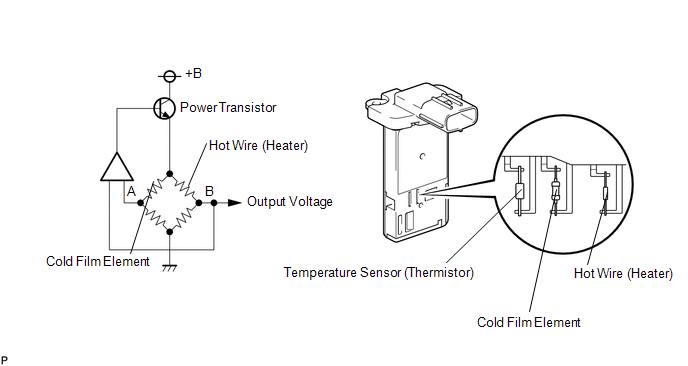
HINT: When either of these DTCs is stored, check the air-flow rate by entering the following menus: Powertrain / Engine and ECT / Data List / MAF.
MONITOR DESCRIPTION If there is a defect in the MAF meter or an open or short circuit, the voltage level deviates from the normal operating range. The ECM interprets this deviation as a malfunction in the MAF meter and stores a DTC. Example: When the sensor output voltage remains at less than 0.2 V, or more than 4.9 V for more than 3 seconds, the ECM stores a DTC. If the malfunction is not repaired successfully, a DTC is stored 3 seconds after the engine is next started. MONITOR STRATEGY
TYPICAL ENABLING CONDITIONS
TYPICAL MALFUNCTION THRESHOLDS P0102
COMPONENT OPERATING RANGE
CONFIRMATION DRIVING PATTERN 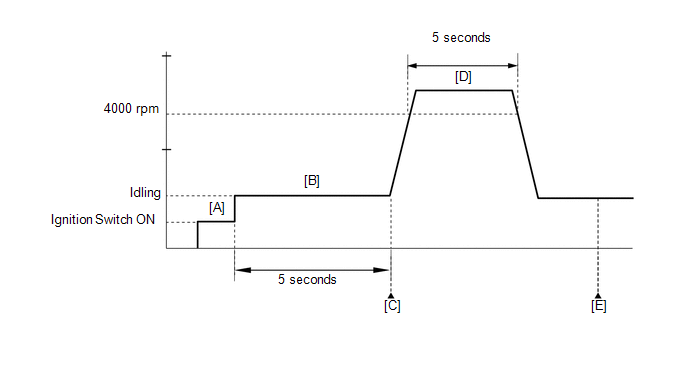
WIRING DIAGRAM 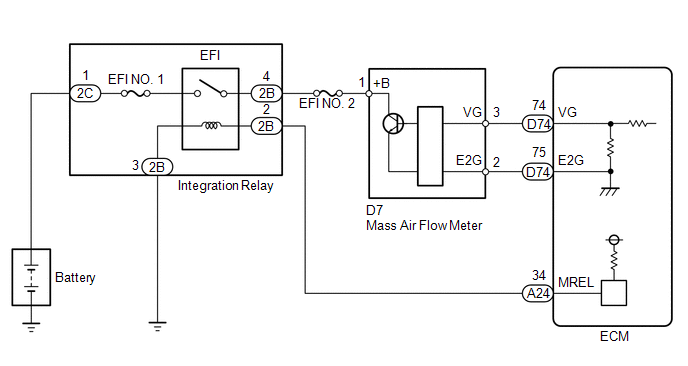 CAUTION / NOTICE / HINT HINT: Read freeze frame data using the Techstream. Freeze frame data records the engine condition when malfunctions are detected. When troubleshooting, freeze frame data can help determine if the vehicle was moving or stationary, if the engine was warmed up or not, if the air-fuel ratio was lean or rich, and other data from the time the malfunction occurred. PROCEDURE
(a) Connect the Techstream to the DLC3. (b) Turn the ignition switch to ON. (c) Turn the Techstream on. (d) Enter the following menus: Powertrain / Engine and ECT / Trouble Codes. (e) Read DTCs. Result
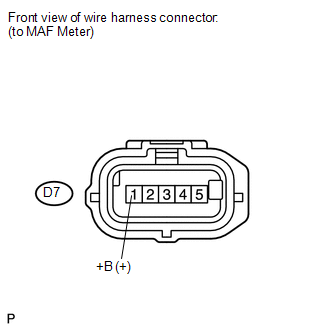 (a) Disconnect the mass air flow meter connector. (b) Turn the ignition switch to ON. (c) Measure the voltage according to the value(s) in the table below. Standard Voltage:
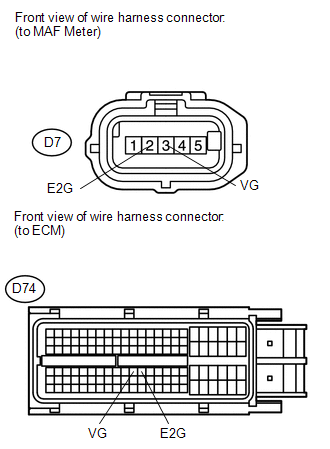 (a) Disconnect the mass air flow meter connector. (b) Disconnect the ECM connector. (c) Measure the resistance according to the value(s) in the table below. Standard Resistance:
(a) Inspect the mass air flow meter, referring to the On-vehicle inspection for mass air flow meter (See page
(b) Inspect the mass air flow meter, referring to the inspection for mass air flow meter (See page
(c) Inspect the function of the mass air flow meter. (1) Connect the Techstream to the DLC3. (2) Turn the ignition switch to ON. (3) Turn the Techstream on. (4) Enter the following menus: Powertrain / Engine and ECT / Data List / MAF. (5) Start the engine. (6) Check that the MAF value changes when the engine is raced. OK: The reading changes. HINT: Perform "Inspection After Repair" after replacing the mass air flow meter (See page
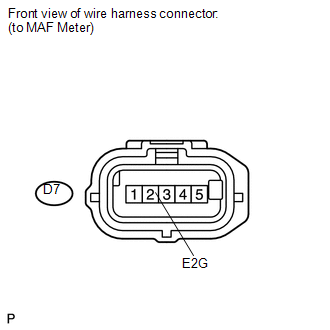 (a) Disconnect the mass air flow meter connector. (b) Measure the resistance according to the value(s) in the table below. Standard Resistance:
HINT: Perform "Inspection After Repair" after replacing the mass air flow meter (See page
 (a) Disconnect the mass air flow meter connector. (b) Disconnect the ECM connector. (c) Measure the resistance according to the value(s) in the table below. Standard Resistance:
(a) Disconnect the mass air flow meter connector. (b) Remove the integration relay from the engine room relay block. (c) Measure the resistance according to the value(s) in the table below. Standard Resistance:
|
Toyota Tundra Service Manual > Headlight Assembly(for Led Headlight): Disassembly
DISASSEMBLY CAUTION / NOTICE / HINT HINT: Use the same procedure for the RH and LH sides. The procedure listed below is for the LH side. PROCEDURE 1. REMOVE FRONT TURN SIGNAL LIGHT BULB (a) Turn the front turn signal light bulb socket in the direction indicated by the arrow to remove it. (b) Remove ...